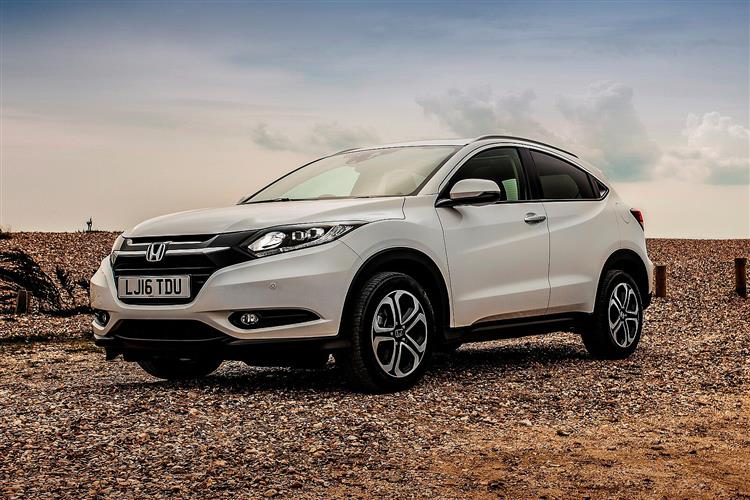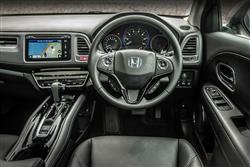How will you view?
This is a sample, showing 30 seconds of each section.
JOY MACHINE MK2 (some text hidden) SECTIONED_new_hondahr-v_2015
By Jonathan Crouch
Introductionword count: 134
Having given other brands the original idea for compact SUV motoring at the turn of the century, Honda waited until 2015 to introduce a more modern interpretation of what a car of this kind should be - this second generation HR-V model. It aimed at the premium end of the Nissan Juke and Renault Captur class, offering smart looks, impressive safety credentials and the choice of petrol or diesel power. Buyers also got a brilliantly practical interior thanks to so-called 'Magic Seat' ingenuity and a slightly larger body shape than is the norm in this sector. If you're shopping for a used car in this segment and you're prepared to stretch your budget a little, we think you'd probably like one. Here, we're going to focus on the pre-facelift 2015-2018 versions of this car.
Modelsword count: 16
5dr compact SUV (1.5 VTEC petrol - 130PS / 1.6 i-DTEC diesel 120PS (S, SE, EX])
Historyword count: 272
The HR-V is the model that should have started the current seemingly insatiable craze for small Crossovers. The original version was launched in 1999 but didn't have either the marketing, the peppy handling or the visual pizzazz that would characterise the segment-defining Nissan Juke at its launch eleven years later. That original HR-V - marketing as 'the Joy Machine' - was withdrawn from Honda's range in 2006 and, amazingly, not replaced. It was a wasted opportunity. Still, the brand learnt from it, with proof of that delivered a decade later with the launch of this second generation version in the Summer of 2015. This MK2 model was initially a rare sight on our roads, with numbers limited by the Mexican factory's priority to satisfy the American market. It was based on much more sophisticated underpinnings in MK2 form, those of Honda's third generation Jazz. Unlike that supermini, there was the option of diesel power too - though not 4WD. Finally, and possibly most significantly, this car was very cleverly sized, offering most of the interior space buyers could expect from a family hatch-based SUV like Nissan's Qashqai but at the same time, the cute looks and nippy manoeuvrability they'd want from the more compact Juke-style SUV models this Honda primarily competed with. Add in a cleverly versatile 'Magic Seat' interior, cutting edge infotainment and class-leading residuals and the result was an appealing package, even at the kind of premium prices being asked from new. This MK2 HR-V sold steadily until the Spring of 2019, when it was facelifted; it's the pre-facelifted 2015-2018 versions of this car though, that we look at here.
What You Getword count: 340
Honda wanted this second generation HR-V to have more universal appeal than its slightly quirkier predecessor, the idea with this MK2 version being to reach a wider cross-section of buyers. If you like the idea of a small but quite spacious SUV model, but find a Nissan Juke too wilfully outlandish, a Peugeot 2008 rather bland and a Jeep Renegade rather ugly, then this, perhaps, could be your car. The so-called 'coupe-like SUV' looks are stylish enough to stand out, without making a statement likely to offend anyone. Up front, thanks to plenty of adjustment for both seat and wheel, it's easy to get comfortable and once you are, you'll be positioned about 100mm higher up than you would be in an ordinary comparably-priced family hatch. It's certainly very nice in a top 'EX'-spec leather-trimmed version, but even on cheaper variants, soft-touch surfaces accented with brushed chrome highlights, piano black finishing and subtle stitching lines do their best to provide a premium feel. In the rear, you'll find that the HR-V is one of the most spacious models in the compact SUV segment. What really marks this HR-V apart from its contemporaries though, is the packaging brilliance of its so-called 'Magic Seat' system, made possible by this Honda's centre-mounted fuel tank layout. This liberates the floor of the cabin and allows all kinds of interior permutations. Let's take just one of them, the 'Magic Seat' 'Tall mode' where the front of the rear seat base rises up and can be locked in a vertical position to leave a cargo height of 1,240mm from floor to ceiling, allowing the object in question to be placed behind the front seats. It's ideal for tall, fragile items - maybe a small potted tree you've bought from the garden centre; or perhaps a bulky item of electrical equipment. The other two 'Magic Seat' settings relate to more conventional cargo configurations. Raise the rear hatch and you'll note the wide cargo opening and low loading lip that pave the way towards a spacious 470-litre boot.
To see the full road test text contact us on 0330 0020 227
Pictures (high res disabled)

.jpg)
|
.jpg)
|
.jpg)
| |||
.jpg)
|
.jpg)
|
.jpg)
| |||
.jpg)
|
.jpg)
|
.jpg)
| |||
.jpg)
|

|
Scoring (subset of scores)
Category: Crossover or SUV 4x4s
| Performance | |
| Handling | |
| Comfort | |
| Space | |
| Styling, Build, Value, Equipment, Depreciation, Handling, Insurance and Total scores are available with our full data feed. | |



